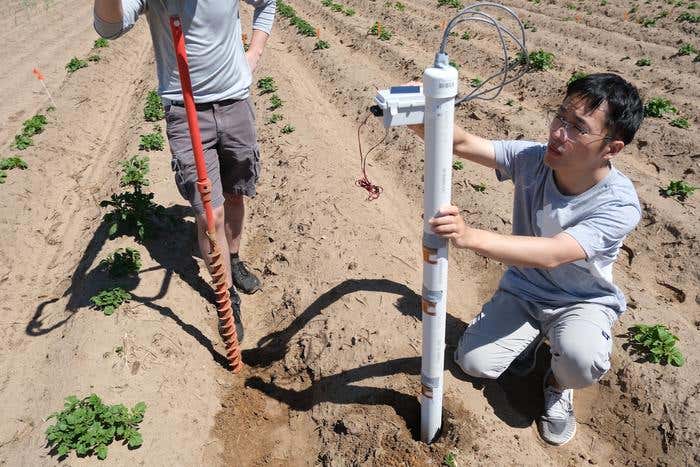Cutting-edge soil sensors boost crop production and cut costs for farmers
The sensors could give farmers a greater understanding of the nutrient profile of their soil and how much nitrate is available for the plants

Soil science PhD student Shuohao Cai places a sensing rod, which has multifunctional sensing stickers positioned to enable multi-depth measurements, in soil at UW-Madison’s Hancock Agricultural Research Station to test the team’s technology. (CREDIT: Kuan-Yu)
Engineers at the University of Wisconsin–Madison have developed affordable sensors for real-time, continuous monitoring of nitrate in common Wisconsin soils. These printed electrochemical sensors could revolutionize nutrient management for farmers, leading to significant economic benefits.
“Our sensors could give farmers a greater understanding of the nutrient profile of their soil and how much nitrate is available for the plants, helping them to make more precise decisions on how much fertilizer they really need,” explains Joseph Andrews, an assistant professor of mechanical engineering who led the research. “If they can buy less fertilizer, the cost savings could be quite significant at large-acreage farms.”
Nitrate is crucial for crop growth but excess amounts can seep into groundwater, posing health risks for those consuming contaminated well water and harming the environment. The new sensors could also be valuable in agricultural research by monitoring nitrate leaching and guiding best practices to mitigate its harmful effects.
Current nitrate monitoring methods in soil are labor-intensive, costly, and lack real-time data. This gap prompted Andrews and his team to develop a more efficient and economical solution.
The team employed inkjet printing to create potentiometric sensors, a type of thin-film electrochemical sensor. While these sensors are typically used to measure nitrate in liquids, they are usually unsuitable for soil due to interference from coarse soil particles.
“The main challenge we were trying to solve is figuring out a way to enable these electrochemical sensors to work well in the harsh environment of soil and accurately sense nitrate ions,” Andrews says.
The breakthrough came with the addition of a polyvinylidene fluoride (PVDF) layer over the sensor. PVDF has two crucial properties: its pores, approximately 400 nanometers in size, allow nitrate ions to pass while blocking soil particles, and it is hydrophilic, meaning it attracts and absorbs water.
“So, any nitrate-laden water gets preferentially soaked into our sensor, and this is really important because soil also acts like a sponge, and you’re going to have a losing battle for getting moisture to come to your sensor unless you can match the water absorption potential of soil,” Andrews explains. “These features of the polyvinylidene fluoride layer enable us to extract the nitrate-laden water, get it to the surface of our sensor and accurately sense nitrate.”
The researchers published their findings in the journal Advanced Material Technologies.
Tests in sandy and silt loam soils, common in different parts of Wisconsin, showed the sensors produced accurate results. The team is now integrating their nitrate sensors into a multifunctional system called a “sensing sticker,” which includes moisture and temperature sensors on a flexible plastic surface with an adhesive backing.
By attaching several sensing stickers to a rod and burying it in the soil, the researchers can measure nitrate, moisture, and temperature at various depths.
“By measuring the nitrate, moisture, and temperature at different depths, we can now quantify the process of nitrate leaching and capture how nitrate is moving through the soil, which hasn’t been possible before,” Andrews says.
Further testing is planned for summer 2024, with 30 sensing rods to be deployed at UW–Madison’s Hancock Agricultural Research Station and Arlington Agricultural Research Station.
The researchers are patenting their technology through the Wisconsin Alumni Research Foundation.
Note: Materials provided above by the The Brighter Side of News. Content may be edited for style and length.
Like these kind of feel good stories? Get the Brighter Side of News' newsletter.
Joshua Shavit
Science & Technology Writer | AI and Robotics Reporter
Joshua Shavit is a Los Angeles-based science and technology writer with a passion for exploring the breakthroughs shaping the future. As a contributor to The Brighter Side of News, he focuses on positive and transformative advancements in AI, technology, physics, engineering, robotics and space science. Joshua is currently working towards a Bachelor of Science in Business Administration at the University of California, Berkeley. He combines his academic background with a talent for storytelling, making complex scientific discoveries engaging and accessible. His work highlights the innovators behind the ideas, bringing readers closer to the people driving progress.



